It is difficult to consider Lord Burlington and his lifelong work as a gentleman architect without a constant nod to his long time collaborator William Kent. Not of gentle birth but someone whose early promise led to support on the Grand Tour by a gaggle of Yorkshire gentry, Kent did languish in Italy for nearly 10 years before his transformative 1719 meeting with Lord Burlington, a man nearly 10 years Kent’s junior, upon the younger man’s sojourn in northern Italy. What attraction these men had for one another has been a matter of speculation for the past 3 centuries, but whatever it was, it lasted the rest of Kent’s life, lodging as he did in Burlington House as an honored member of the household until his death in 1748.
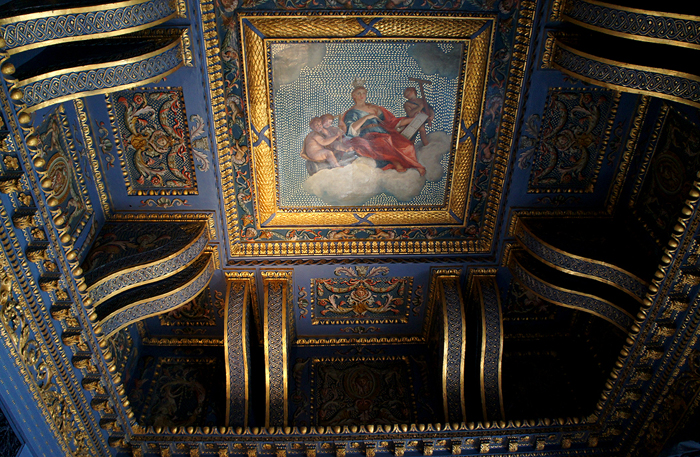
Chiswick House- ceiling of the blue velvet room, with an allegory of architecture
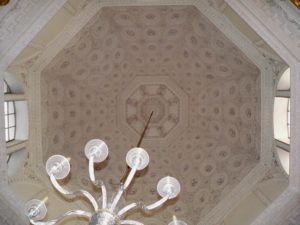
The ceiling of the saloon or ‘tribunal’ at Chiswick House
It is also difficult to know where Burlington’s work ends and Kent’s begins, but suffice to say, they both brought back to England a Palladianism that sought to capture an Italianate style of decoration, both without and within, that was a marked departure from the Baroque style then in vogue. Sometimes, though, as at Chiswick House, Kent’s work can seem more than a little ponderous. With its intense colour and riot of decoration, the Blue Velvet Room is rendered nearly claustrophobic, with its ceiling an allegory of architecture, bespeaking an econcomium to Kent’s patron Lord Burlington. It is in scale though perhaps more appropriate to a very much larger space. The saloon or tribunal, as well, positioned as it is to be the main gathering place within Chiswick House, seems small and pokey, despite being well lit from above with the placement of ‘thermal’ windows. Nevertheless, coffering appears small and fussy, and visually less effective than that in the original vastness of the Pantheon the saloon sought to evoke.
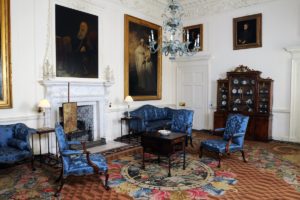
The drawing room, Dumfries House, with blue damask upholstery
A quick sidebar, the use of a blue ground colour in the Blue Velvet Room, its pigment perhaps derived from turnsole, was a striking inclusion. As mentioned in my earlier blog, the exterior elevations of Lord Dumfries’ slightly later house was influenced by Burlington and Chiswick House. Although the interior of Dumfries House is rendered in a less antiquarian, more pedestrian rococo style, the damask covering of most of the soft furnishings including the pelmet and hangings of the bed of state are in the same, turnsole blue. It is further worth noting that Lord Dumfries was particularly insistent that the fabric of this colour be used.
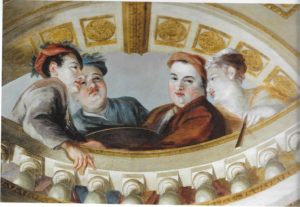
Portion of the Great Staircase, Kensington Palace, with William Kent in turban, by William Kent’
But as with Chiswick House generally, its interior design, including furnishings, function as a manifestation of a new style in architecture and design with a focus on an antiquity particularly Roman in character that achieved a striking resonance in the Britain of its day. While certainly the political influence of Lord Burlington was instrumental in obtaining appointments for William Kent, patronage of Burlington’s older protégé moved very quickly apace. Royal appointments included decorative commissions for George II at Kensington Palace and perhaps most significant of all, an enormous amount of work for the first prime minister, Sir Robert Walpole.
The overarching figure of his day, Sir Robert Walpole, also of relatively humble birth, was extraordinarily useful to the court, bridging successfully as he did between Parliament and the king, easing the way for the German Hanoverian monarch and maintaining a long-lived, albeit fractious balance between Whigs and Tories. With an era known even in its day as the Robinopolis, Walpole himself was aware of and sought to promote his political success with a visual language that found its most obvious vocabulary in the virtue of the republican Rome of antiquity, in which Kent, as it happened, was particularly conversant.
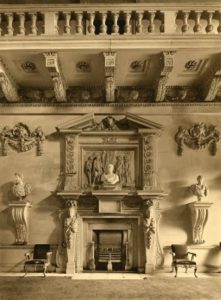
Stone Hall, Houghton, with bust of Sir Robert Walpole in the Roman manner above the fireplace
Walpole’s supreme expression of worldly and political success was his stately home, Houghton. While its Palladian exterior is the work of Burlington’s contemporary Colen Campbell, the interior design and decoration, and including the furniture, is wholly the work of Kent.
By contrast, though, Kent was also engaged in a variety of tasks both public and private that were at times considerably removed from his initial association not only with Lord Burlington, but also with a type Palladianism with ancient Roman overtones. More on this in a later blog, but suffice to say, it is indicative of the character and affability of Kent that he was generally companionable and well liked. His appointments and commissions had arguably at least as much to do with Lady Burlington, as lady of the bedchamber to Queen Caroline, as to her husband. Lady Burlington’s surviving correspondence are full of endearments directed at Kent, referring to him variously as her dear little ‘signor’ and ‘Kentino’. Whatever the relationship between Kent and Lord Burlington, it did not seem to interfere with the regard in which Lady Burlington held the man, who, along with her husband, spent his entire life in her household.
Pundits since the time of and including Horace Walpole have tried to impart a political message contained within sometimes abstruse symbolism and motifs in the work of Kent. What seems more obvious, given the variety of styles employed and political persuasions of those for whom Kent worked, he was in his day, to put not too fine a point on it, fashionable. It seems that fashion and the freemasonry of the rich and aristocratic did then, as now, override political divisions. Indeed, Kent himself had the final word on the subject, writing in his own idiosyncratic fashion that ‘ as Politicke are not my genius, it diverts me much now at night to look & read of these fine remaines of Antiquety.’
For reference:
The last two decades have seen much written to reexamine the life and work of Kent who’s remained by and large in the shadow of his most long-lived patron, Richard Boyle, 3rd Earl of Burlington. The exhibition staged at the Bard Graduate Center in New York and at the Victoria and Albert Museum in London entitled ‘William Kent: Designing Georgian Britain’ was an exhaustive examination of the life and work of Kent. The catalog and essays accompanying the exhibition, edited by Susan Weber, are a tour de force and do much to elucidate and rehabilitate the reputation Kent enjoyed in his lifetime.
Susan Weber, ed., William Kent: Designing Georgian Britain, Yale University Press, 2013
